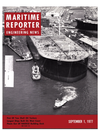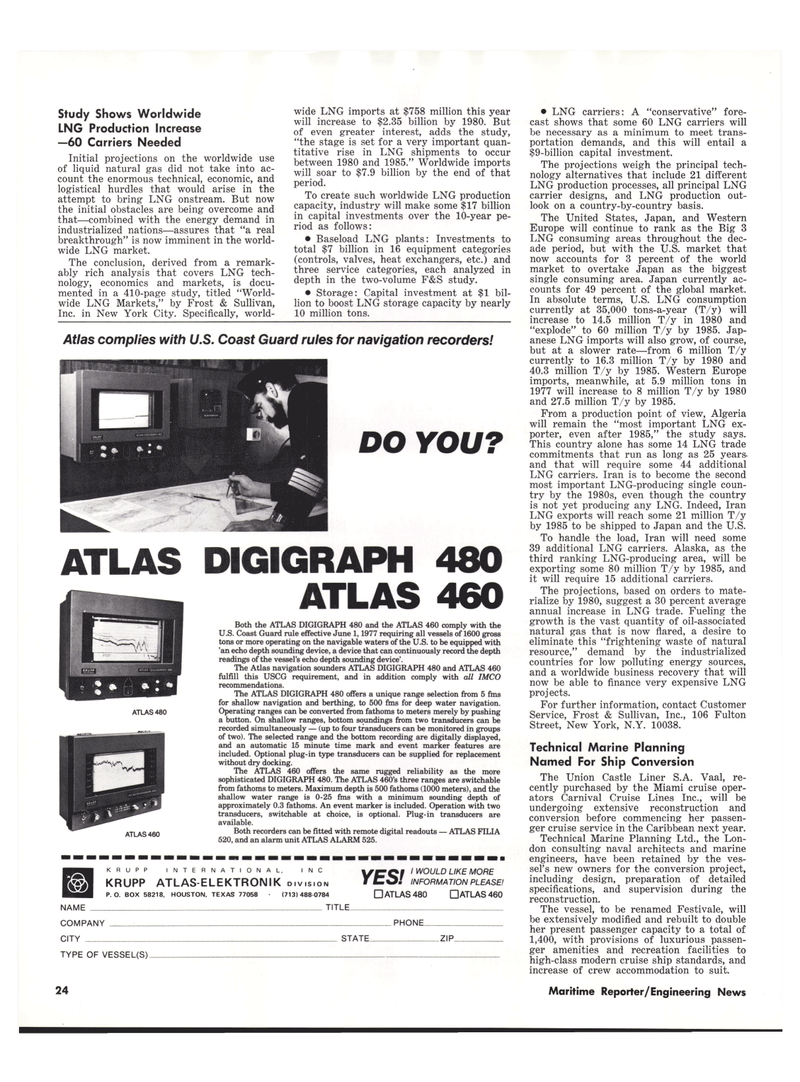
Page 22: of Maritime Reporter Magazine (September 1977)
Read this page in Pdf, Flash or Html5 edition of September 1977 Maritime Reporter Magazine
Study Shows Worldwide
LNG Production Increase —60 Carriers Needed
Initial projections on the worldwide use of liquid natural gas did not take into ac- count the enormous technical, economic, and logistical hurdles that would arise in the attempt to bring LNG onstream. But now the initial obstacles are being overcome and that—combined with the energy demand in industrialized nations—assures that "a real breakthrough" is now imminent in the world- wide LNG market.
The conclusion, derived from a remark- ably rich analysis that covers LNG tech- nology, economics and markets, is docu- mented in a 410-page study, titled "World- wide LNG Markets," by Frost & Sullivan,
Inc. in New York City. Specifically, world-
K R U P P IN
KRUPP ATL
HBM P. O. BOX 58218, HC
NAME
COMPANY
CITY
TYPE OF VESSEL(S) wide LNG imports at $758 million this year will increase to $2.35 billion by 1980. But of even greater interest, adds the study, "the stage is set for a very important quan- titative rise in LNG shipments to occur between 1980 and 1985." Worldwide imports will soar to $7.9 billion by the end of that period.
To create such worldwide LNG production capacity, industry will make some $17 billion in capital investments over the 10-year pe- riod as follows: • Baseload LNG plants: Investments to total $7 billion in 16 equipment categories (controls, valves, heat exchangers, etc.) and three service categories, each analyzed in depth in the two-volume F&S study. • Storage: Capital investment at $1 bil- lion to boost LNG storage capacity by nearly 10 million tons.
DO • LNG carriers: A "conservative" fore- cast shows that some 60 LNG carriers will be necessary as a minimum to meet trans- portation demands, and this will entail a $9-billion capital investment.
The projections weigh the principal tech- nology alternatives that include 21 different
LNG production processes, all principal LNG carrier designs, and LNG production out- look on a country-by-country basis.
The United States, Japan, and Western
Europe will continue to rank as the Big 3
LNG consuming areas throughout the dec- ade period, but with the U.S. market that now accounts for 3 percent of the world market to overtake Japan as the biggest single consuming area. Japan currently ac- counts for 49 percent of the global market.
In absolute terms, U.S. LNG consumption currently at 35,000 tons-a-year (T/y) will increase to 14.5 million T/y in 1980 and "explode" to 60 million T/y by 1985. Jap- anese LNG imports will also grow, of course, but at a slower rate—from 6 million T/y currently to 16.3 million T/y by 1980 and 40.3 million T/y by 1985. Western Europe imports, meanwhile, at 5.9 million tons in 1977 will increase to 8 million T/y by 1980 and 27.5 million T/y by 1985.
From a production point of view, Algeria will remain the "most important LNG ex- porter, even after 1985," the study says.
This country alone has some 14 LNG trade commitments that run as long as 25 years, and that will require some 44 additional
LNG carriers. Iran is to become the second most important LNG-producing single coun- try by the 1980s, even though the country is not yet producing any LNG. Indeed, Iran
LNG exports will reach some 21 million T/y by 1985 to be shipped to Japan and the U.S.
To handle the load, Iran will need some 39 additional LNG carriers. Alaska, as the third ranking LNG-producing area, will be exporting some 80 million T/y by 1985, and it will require 15 additional carriers.
The projections, based on orders to mate- rialize by 1980, suggest a 30 percent average annual increase in LNG trade. Fueling the growth is the vast quantity of oil-associated natural gas that is now flared, a desire to eliminate this "frightening waste of natural resource," demand by the industrialized countries for low polluting energy sources, and a worldwide business recovery that will now be able to finance very expensive LNG projects.
For further information, contact Customer
Service, Frost & Sullivan, Inc., 106 Fulton
Street, New York, N.Y. 10038.
Technical Marine Planning
Named For Ship Conversion
The Union Castle Liner S.A. Vaal, re- cently purchased by the Miami cruise oper- ators Carnival Cruise Lines Inc., will be undergoing extensive reconstruction and conversion before commencing her passen- ger cruise service in the Caribbean next year.
Technical Marine Planning Ltd., the Lon- don consulting naval architects and marine engineers, have been retained by the ves- sel's new owners for the conversion project, including design, preparation of detailed specifications, and supervision during the reconstruction.
The vessel, to be renamed Festivale, will be extensively modified and rebuilt to double her present passenger capacity to a total of 1,400, with provisions of luxurious passen- ger amenities and recreation facilities to high-class modern cruise ship standards, and increase of crew accommodation to suit.
Atlas complies with U.S. Coast Guard rules for navigation recorders!
ATLAS DIGIGRAPH 480 ATLAS 460
Both the ATLAS DIGIGRAPH 480 and the ATLAS 460 comply with the
U.S. Coast Guard rule effective June 1,1977 requiring all vessels of 1600 gross tons or more operating on the navigable waters of the U.S. to be equipped with 'an echo depth sounding device, a device that can continuously record the depth readings of the vessel's echo depth sounding device'.
The Atlas navigation sounders ATLAS DIGIGRAPH 480 and ATLAS 460 fulfill this USCG requirement, and in addition comply with all IMCO recommendations.
The ATLAS DIGIGRAPH 480 offers a unique range selection from 5 fms for shallow navigation and berthing, to 500 fins for deep water navigation.
Operating ranges can be converted from fathoms to meters merely by pushing a button. On shallow ranges, bottom soundings from two transducers can be recorded simultaneously — (up to four transducers can be monitored in groups of two). The selected range and the bottom recording are digitally displayed, and an automatic 15 minute time mark and event marker features are included. Optional plug-in type transducers can be supplied for replacement without dry docking.
The ATLAS 460 offers the same rugged reliability as the more sophisticated DIGIGRAPH 480. The ATLAS 460's three ranges are switchable from fathoms to meters. Maximum depth is 500 fathoms (1000 meters), and the shallow water range is 0-25 fins with a minimum sounding depth of approximately 0.3 fathoms. An event marker is included. Operation with two transducers, switchable at choice, is optional. Plug-in transducers are available.
Both recorders can be fitted with remote digital readouts — ATLAS FILIA 520, and an alarm unit ATLAS ALARM 525.
ATLAS 480
ATLAS 460 rERNATIONAL, INC \S-ELEKTRONIK DIVISION
ISTON, TEXAS 77058 • (713) 488-0784
TITLE^ yrQI I WOULD LIKE MORE
T C O- IN FORMA TION PLEASE! • ATLAS 480 • ATLAS 460
PHONE
STATE _ZIP_ 20 Maritime Reporter/Engineering News

 21
21

 23
23
